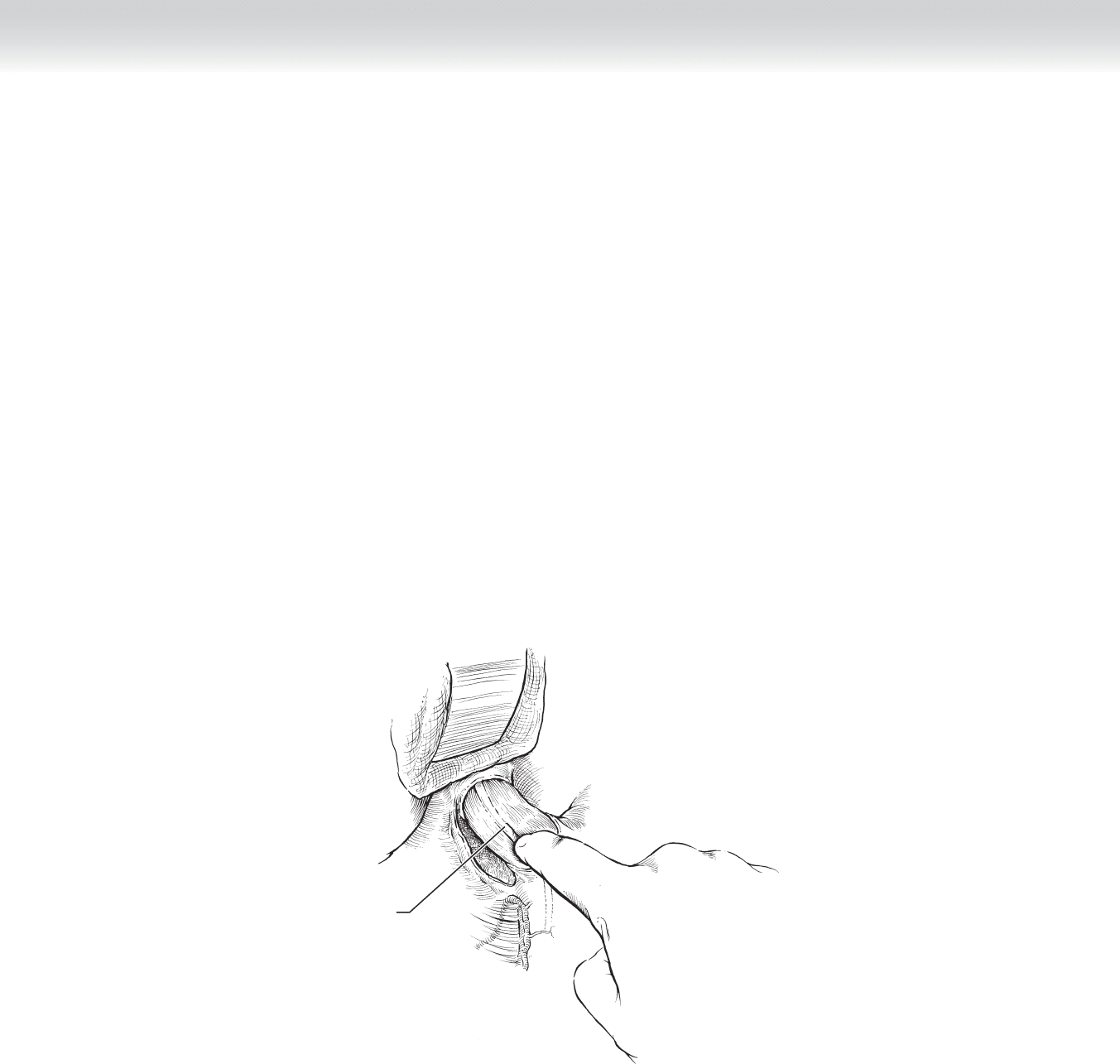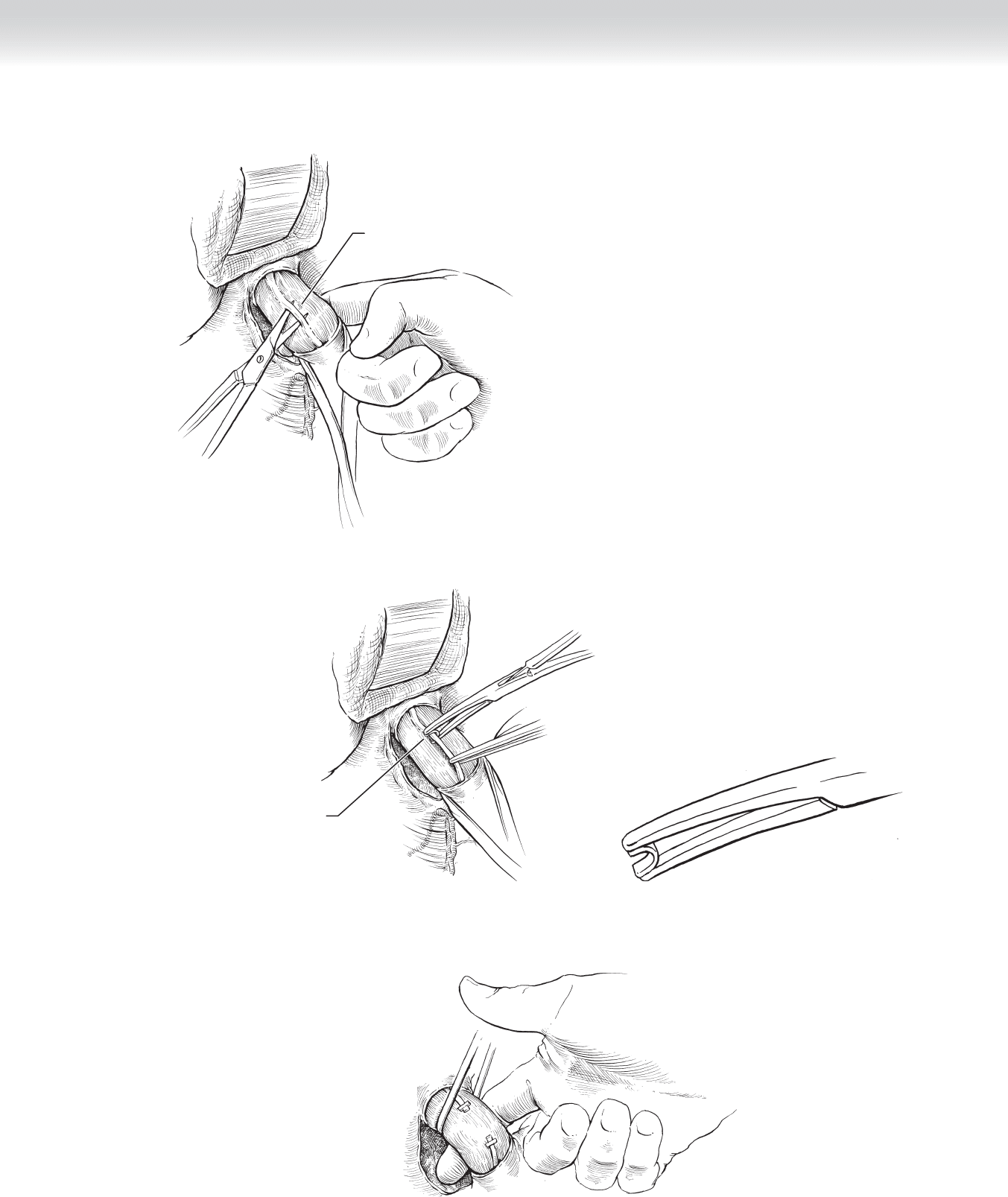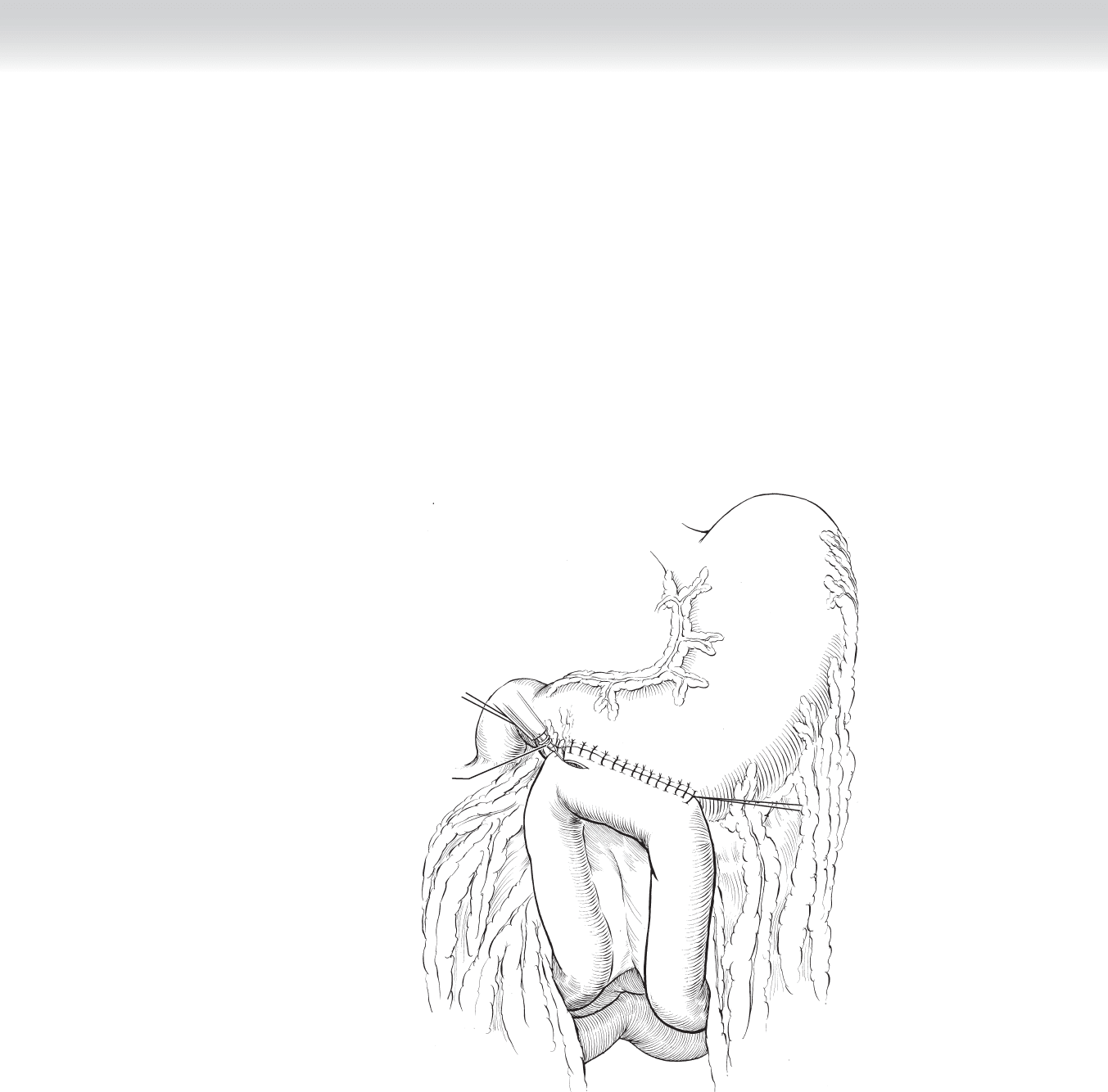Townsend Courtney M.Jr., Evers B. Mark. Atlas of General Surgical Techniques: Expert Consult
Подождите немного. Документ загружается.


CHAPTER 31 • Truncal Vagotomy 329
Incising peritoneum
FIGURE 31–3
Anterior
vagus nerve
Incise peritoneum
over esophagus
FIGURE 31–2
MC
Posterior
vagus nerve
Anterior
vagus nerve
FIGURE 31–1

330 Section IV • The Abdomen
◆ Once the peritoneum is incised, the index fi nger is placed around the esophagus to encircle
it at the hiatus. Care should be taken to pass the fi nger around the esophagus above the di-
aphragm to ensure that the posterior vagus is included in this maneuver. A Penrose drain is
then normally placed around the distal esophagus, and the anterior vagus nerve is identi-
fi ed lying in the substance of the anterior esophagus (Figure 31-4).
◆ The anterior vagus nerve is then dissected and freed from the underlying esophagus
(Figure 31-5). In performing the truncal vagotomy, we place small metal clips on the vagus
nerve and excise a 2-cm segment between the clips. Excised vagal segments are sent for
pathologic examination of permanent sections (Figure 31-6).
◆ Traction is placed on the Penrose drain and the posterior vagus nerve identifi ed (Figure 31-7).
◆ The procedure is repeated for the larger posterior nerve. Clips are placed and at least a
2-cm segment of the nerve is excised.
Anterior vagus nerve
FIGURE 31–4

CHAPTER 31 • Truncal Vagotomy 331
Mobilizing vagus nerve
FIGURE 31–5
BA
Clipping anterior vagus nerve
FIGURE 31–6
FIGURE 31–7

332 Section IV • The Abdomen
◆ Care should be taken to identify and divide any accessory vagal fi bers. As many as fi ve
accessory vagal trunks have been reported, but most individuals have only two main trunks
(Figure 31-8).
◆ A drainage procedure such as pyloroplasty or gastroenterostomy is then used to complete
the procedure.
3. CLOSING
◆ The midline incision is closed in the standard fashion.
STEP 4: POSTOPERATIVE CARE
◆ A nasogastric tube is placed to suction, and when return of bowel function is noted, the
nasogastric tube is removed and clear liquids started.
STEP 5: PEARLS AND PITFALLS
◆ Truncal vagotomy is usually a safe and effective method for defi nitive operative treatment of
ulcer disease. The trunks should be clearly identifi ed and at least a 2-cm segment excised
and confi rmed as nerve tissue by pathology.
Dividing
posterior vagus nerve
FIGURE 31–8

CHAPTER 31 • Truncal Vagotomy 333
◆ As noted, a careful assessment and identifi cation of accessory vagal fi bers should be under-
taken to prevent ulcer recurrence.
◆ Truncal vagotomy must always be accompanied by a drainage procedure to prevent gastric
stasis.
SELECTED REFERENCES
1. Mercer DW, Robinson EK: Stomach. In Townsend CM Jr (ed): Sabiston Textbook of Surgery: The Biological
Basis of Modern Surgical Practice, 18th ed. Philadelphia, Saunders, 2008, pp 1223-1277.
2. Thompson JC: Truncal vagotomy. In Thompson JC (ed): Atlas of Surgery of the Stomach, Duodenum and
Small Bowel. St Louis, Mosby-Year Book, 1992, pp 71-75.

334
STEP 1: SURGICAL ANATOMY
◆ Understanding the anatomy of the stomach and small bowel and determining whether an
antecolic or retrocolic approach is more appropriate are key points in this procedure.
STEP 2: PREOPERATIVE CONSIDERATIONS
◆ Gastrojejunostomy can be performed in an antecolic fashion, which provides a quick and
effective method of connecting the distal stomach to the jejunum. In some instances, the
more direct path is a retrocolic anastomosis involving placement of the jejunal loop through
the transverse colon mesentery.
◆ Gastrojejunostomy is usually performed to bypass an obstructed distal stomach or duode-
num and provide relief. This is particularly useful in cancers that obstruct the duodenal
lumen or the distal stomach and are not resectable. Gastrojejunostomy should also be con-
sidered in the patient who requires a drainage procedure in whom a pyloroplasty may not
be safe because of chronic scarring of the duodenal bulb.
STEP 3: OPERATIVE STEPS
1. INCISION
◆ Using an open technique, an upper midline incision is usually performed. We are illustrating
the open technique in this chapter; however, gastrojejunostomy may be also accomplished
via laparoscopy.
CHAPTER
32
Gastrojejunostomy
B. Mark Evers

2. DISSECTION
◆ To create an antecolic gastrojejunostomy, the surgeon identifi es a convenient section of dis-
tal stomach and a loop of jejunum that is easily maneuverable to the stomach distal to the
ligament of Treitz. A convenient location in the proximal jejunum is usually 15 to 20 cm
distal to the ligament of Treitz.
◆ A posterior row of seromuscular 3-0 silk sutures are placed in Lembert fashion to connect
the stomach and the jejunum. If a stapled anastomosis is to be performed, an enterotomy is
created using electrocautery; likewise, a gastrotomy is also performed to facilitate placement
of the stapler (Figure 32-1).
MC
Creating an opening
in jejunum for stapler
FIGURE 32–1
CHAPTER 32 • Gastrojejunostomy 335

336 Section IV • The Abdomen
◆ The gastrointestinal anastomosis (GIA) stapling device is placed through the holes created
in the stomach and the jejunum, and the anastomosis is performed by fi ring the stapler
(Figure 32-2).
◆ The enterotomy and gastroenterotomy are closed together using a transanastomotic (TA)
stapling device (Figure 32-3).
◆ Figure 32-4 demonstrates the complete antecolic gastrojejunostomy.
Stapler dividing excess
gastrojejunal tissue
Stapler used to create an
opening in stomach and jejunum
FIGURE 32 –2
FIGURE 32 –3

CHAPTER 32 • Gastrojejunostomy 337
◆ Figure 32-5 demonstrates the technique for a handsewn antecolic gastrojejunostomy. The
posterior row of Lembert 3-0 silk sutures are placed as noted previously. Electrocautery is
used to open the jejunum and the stomach, thereby creating the jejunal and gastric stomas
(Figure 32-6).
Jejunal serosa
FIGURE 32 –5
Complete antecolic
gastrojejunostomy
FIGURE 32 –4

338 Section IV • The Abdomen
◆ The inner layer of the anastomosis is performed using a running full-thickness absorbable suture,
such as 3-0 chromic or Vicryl, which is then carried anteriorly in a Connell fashion (Figure 32-7).
Jejunal stoma
Creating a gastric stoma
FIGURE 32 –6
Running closure
of posterior
mucosal layer
FIGURE 32 –7
